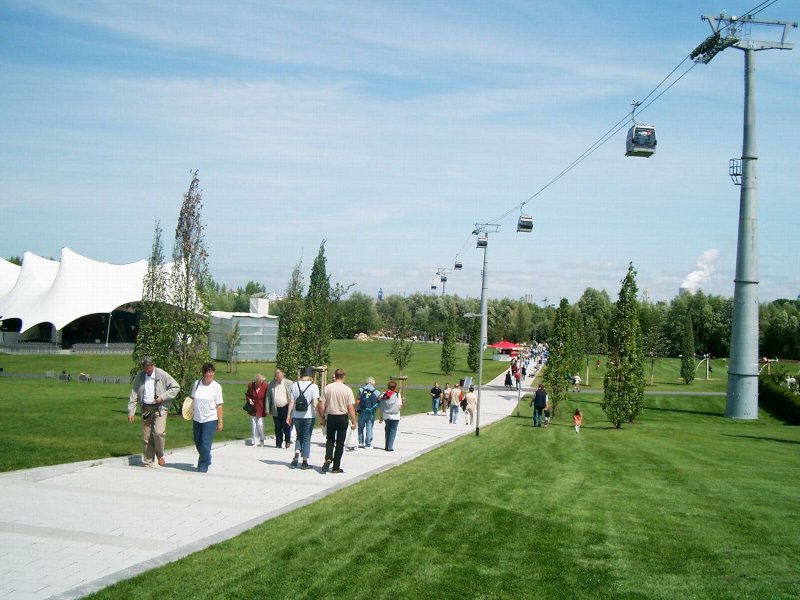Take a look at that picture again . . . Now take a look at this one:
Looks like the same system, right? Well, you’re sort of right and sort of wrong.
It is, indeed, the same system, but they’re in two different cities!
For those who don’t know (and I certainly didn’t), the biannual Federal horticulture show in Germany (BUGA) is a big deal. The 2009 show in Schwerin welcomed 1.8 million visitors over 4 months and the 2011 show expects over 2 million visitors.
The two images above were from the 2003 BUGA in Rostock and the 2005 BUGA in Munich, respectively. To provide an aerial view of the show grounds, Doppelmayr installed a simple Monocable Detachable Gondola. At the end of the show in Rostock, the system was disassembled and reassembled in Munich.
How about doing the same thing for an urban transit system? A test drive, if you will.
Would it be a long system? Probably not, but it wouldn’t have to be. It would just have to make a point.
For example, the 2011 BUGA in Koblenz is building a short 850 m long system, but it will carry 7,000 passengers per hour, well in excess of most light rail lines in North America.
The most exciting thing about the Koblenz system is that it is not the basic MDG used in Rostock and Munich. From the pictures I’ve seen, it appears to be a 3S, the most advanced aerial cable system on the planet. The 3S was popularized by Doppelmayr with their Peak-2-Peak at Whistler-Blackcomb and will receive significant attention during the upcoming winter games in Vancouver.
The big question is whether or not this will be a temporary installation. The stations are tiny compared to those in Whistler (a good thing for any urban environment), which suggests it is, but I can find no information to support or deny that assumption.
If it is a temporary installation, could it be toured? Could a city just try it out? Kick the tires a bit?
I often talk about the No City Wants to be First Problem. It’s a clear problem when it comes to purchasing transit infrastructure, but does the problem exist if extended to testing transit infrastructure? I’m not sure that it would.
I suspect a touring cable transit system would have no shortage of cities interested.
Who wants to be first?
Images from Dr. Alex Rollrasen, Allie Caulfield, and the Koblenz 2011 homepage.




8 Comments
oh, i want one!
what kinda price tag we looking at here?
Hi,
the Koblenz system for the BUGA is at the moment ment to be temporary.
It is still owned by the manufacturer Doppelmayr who is running it as well.
Not the BUGA organizers.
As far as know there are two issues:
1) The UNESCO only allowed it to be temporary. If permanently installed they would take away the title of UNESCO world heritage for the middle rhine valley in Koblenz (cables are crossing the river).
2) Doppelmayr will be able to decide if the system can be run economically without the attraction of the BUGA after 2011… or if it is more economically to install it somewhere else. It is clear that the system will run also in 2012 and has to be removed for the UNESCO-issue in winter 2012/2013.
To my knowledge the city of Koblenz is in discussions with both, UNESCO and Doppelmayr, as they would like to keep the stylish and innovative symbol within their city.
Hi David,
I didn’t know that UNESCO was involved in this decision. Thanks!
The Koblenz system is set to start up operation again in the spring (2012) and continue to run for 2 years, according to:
http://www.doppelmayr.com/en/doppelmayr-international/communication/news/detail.html?tx_ttnews%5Btt_news%5D=1187&cHash=f17b1a8a92